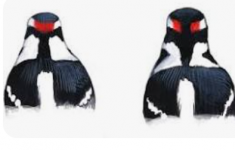ShortyTheSpotter
Member






Thanks. Those aren't mine though (if that's what you mean). I think those are Sibley illustrations.A great illustration Beth!
You got it - when it's not possible to judge size reliably, that's (as near as makes no difference) all there is. Depending on where you are (btw, where are you? - you don't say and that's an essential piece of information for every ID), and on what the pattern is, the outer tail-feathers may also be useful; your field guide will give you the details.what is the difference between these two (besides the long/short bill)?
Is this the feature in Sibley's blog? I had a look at that a long time ago and concluded it was really dubious.In the East you can separate them by looking at the red patch on the back of the head.
If it's divided by a black line it's a Hairy.

Here's the source: Another clue for identifying Downy and Hairy Woodpeckers – Sibley GuidesIs this the feature in Sibley's blog? I had a look at that a long time ago and concluded it was really dubious.

Looks to be a Downy.
In the East you can separate them by looking at the red patch on the back of the head.
If it's divided by a black line it's a Hairy. Also, look for the barring under the tail for the Downy. From a side view
of the Downy the outside tail feathers look like they have a few spots (from the barring). The outside tail feathers on
the Hairy will look white with no spots. Sometimes this is hard to see.
Also, Hairy Woodpeckers have a shoulder spur; a black line extending out from the shoulder. Downy can exhibit a shoulder spur
as well, but it's not as pronounced.
Eventually you should be able to separate them much of the time by size and bill length.
It was a bit challenging for me. I am completely new to birding and I have no reference yet. At least for me, the camera angle wasn't perfect for that decision. I'm sorry that I didn't mention the Location. I took the Picture in south east Pennsylvania.You got it - when it's not possible to judge size reliably, that's (as near as makes no difference) all there is. Depending on where you are (btw, where are you? - you don't say and that's an essential piece of information for every ID), and on what the pattern is, the outer tail-feathers may also be useful; your field guide will give you the details.
Is this the feature in Sibley's blog? I had a look at that a long time ago and concluded it was really dubious.

If you want to get seriously into bird ID, one of the Sibley books is an essential (though this head-pattern feature isn't in them). I would also urge you to spend more time looking through binoculars than through a camera - this is the way to true enlightenment 😉
I (carefully) didn't say that I thought you don't do that - nor that you shouldn't take photos. But... there is a whole huge lot more to be learnt about birds and birding than can be acquired from photos - and, being the consuming occupation that it is, time spent taking photos will tend to reduce time spent learning by watching. Like so much in Life, a balance is nice - but, the natural tendency is to secure better and better shots - better than is necessary simply for identification - and striving for photo-quality will definitely eat into watching/learning time. It's a personal choice.I don’t know what makes you think that I don’t do that
Perhaps that's why I'm so crap at identification.I (carefully) didn't say that I thought you don't do that - nor that you shouldn't take photos. But... there is a whole huge lot more to be learnt about birds and birding than can be acquired from photos - and, being the consuming occupation that it is, time spent taking photos will tend to reduce time spent learning by watching. Like so much in Life, a balance is nice - but, the natural tendency is to secure better and better shots - better than is necessary simply for identification - and striving for photo-quality will definitely eat into watching/learning time. It's a personal choice.


Perhaps that's why I'm so crap at identification.
Here's a shot of a Hairy Woodpecker I took this morning.
Short bill, pinched-in white under the eye, black spots on outer tail feathers == it's a Downy, not a Hairy.Perhaps that's why I'm so crap at identification.
Here's a shot of a Hairy Woodpecker I took this morning.
View attachment 1472374
Short bill, pinched-in white under the eye, black spots on outer tail feathers == it's a Downy, not a Hairy.
You ‘experts’ are way too serious and full of yourselves. Notice the file name? Notice the winky emoji.Grow up.

